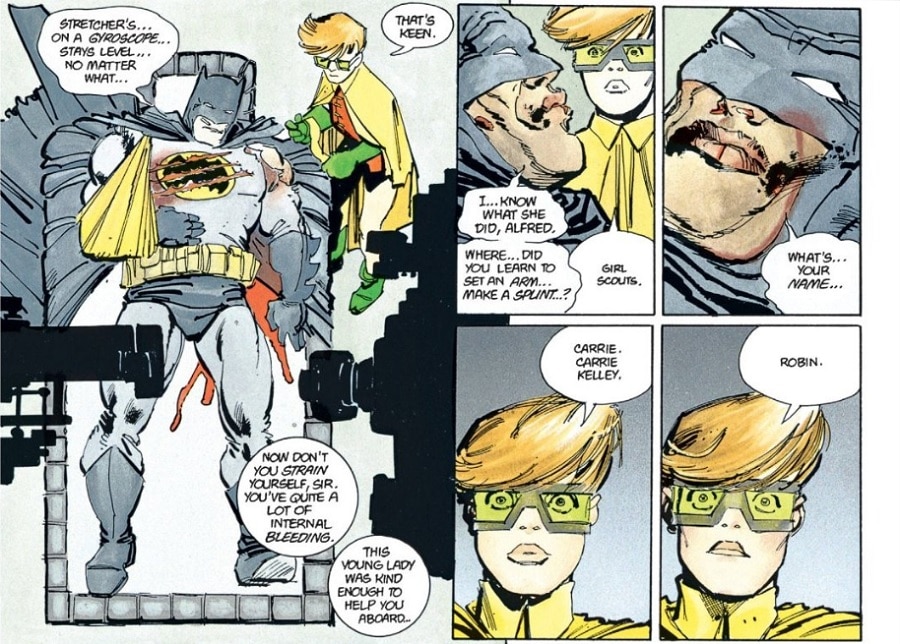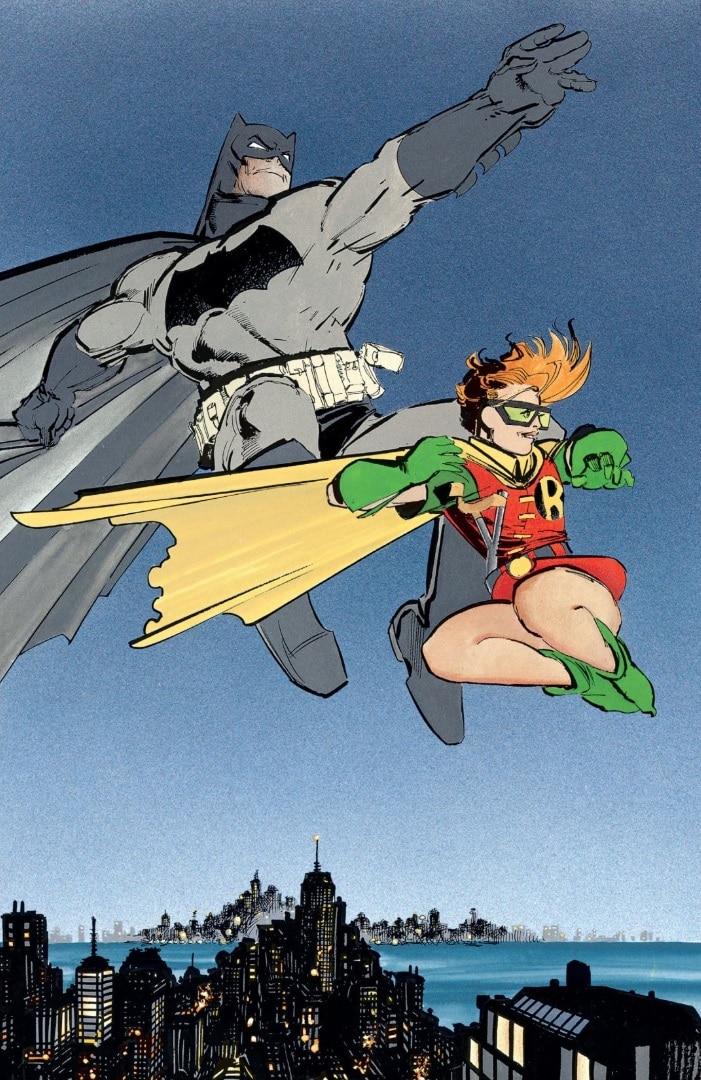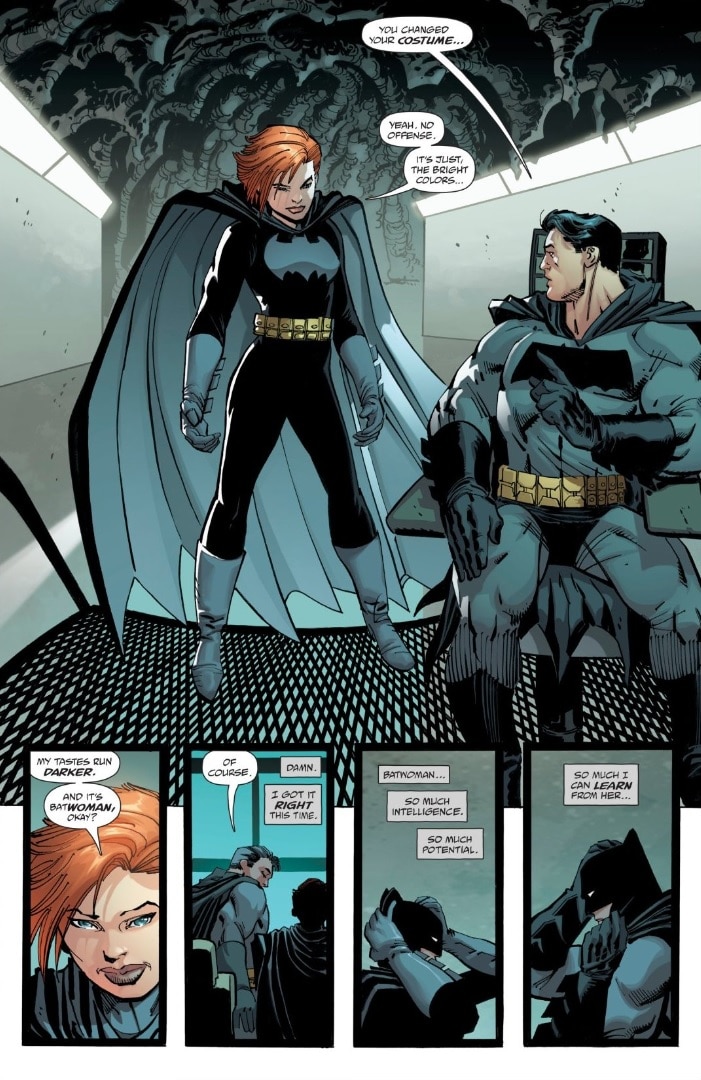Many have worn the mantle of Robin. The first was a young orphan called Dick Grayson, the second was a troubled boy named Jason Todd, and though you may think that the third was Tim Drake, it was actually a 13-year-old girl known as Carrie Kelley who first appeared in the pages of 1986's Bat-Smash, The Dark Knight Returns #1. Created by Frank Miller, Carrie upset the idea of what a sidekick should and could be. She wasn't a lonesome child who needed looking after. In fact, she actually sought out Batman and the role of Robin after the cranky hero saved her from a Mutant attack. After using her lunch money to buy a Robin costume, she took to the streets, redefining the silhouette and spirit of the Caped Crusaders forever!
Unlike the other kids who took on the responsibility of being Robin before her, Carrie isn't an orphan—though her parents are never actually seen in the comics—and she comes right out of the gate taking action in a way that immediately sets her apart and proves just how fearless she truly is. On a dark Gotham night, as Batman is getting pummeled by the Mutant Leader, Carrie saves him by jumping onto the back of the terrifying gang leader and scratches at his eyes until he frees Batman. Though Bruce had technically retired after the death of Jason Todd and the utilitarian government bringing in strict anti-superhero laws, Carrie's actions inspire Bruce to become the hero he once was even though the city he loves has changed beyond recognition.

Until this point, Bruce had only really had relationships with women who were either romantic interests, enemies or maternal figures, but in Carrie he found a partner. The young girl took on the role and responsibilities of Robin with a passion that belied her age and soon became a major player in Batman's world. 1986 was a banner year for so-called "mature comics" with both Miller’s The Dark Knight Returns and Alan Moore and Dave Gibbons’ Watchmen. Two years later, they would be followed up by Batman: The Killing Joke, also written by Moore and drawn by Brian Bolland, cementing the trifecta of comics that would change the shape of the industry for decades.
Out of the three, The Dark Knight Returns stands out as a surprisingly progressive representation of womanhood. Carrie is a strong-headed, independent girl who's never played as a victim or a love interest. The Killing Joke famously saw another of Batman's brilliant women, Barbara Gordon, assaulted and shot by the Joker. Watchmen devoted plenty of its pages to the nagging need of Laurie Jupiter to have a normal relationship in the face of her husband's cosmic transformation and featured the attempted rape of her mother at the hands of the Comedian.
Carrie, though, never befell those fates. In fact, she faced down not only the Joker, but no less than Superman, helping Bruce defeat Krypton's most famous son. Her costume is iconic and non-sexualized, appropriate for her age and infinitely cool. From the class of 1986, Carrie still stands as one of the most powerful women introduced by any DC imprint.

Carrie Kelley's influence has become so large that her look is often referenced in other media, serving as the basis for The Lego Batman Movie's Robin—despite him actually being Dick Grayson—and in the Batman: The Brave and the Bold as the inspiration for Damian Wayne's Mutant fighting son. For a whole generation of fans who came to comics through The Dark Knight Returns, Carrie Kelley was the first Robin that they ever encountered and is still shaping their fandom to this day.
It’s fitting that Carrie paved the way for the first canonical female Robin, Stephanie Brown, and would go on to have a future well beyond the book she’s most famous for. She returned as Catgirl in Miller’s sequel, The Dark Knight Strikes Again, and was even introduced into DC continuity for a little while during the New 52 relaunch. Most recently, Carrie briefly took on the mantle of Batman in Miller’s third book in the series, Dark Knight III: The Master Race, before being officially made Batgirl in that continuity and eventually Batwoman—a name she chose for herself.

We can only speculate on where Carrie Kelley goes from here, but if her story were to end with the final pages of this third Dark Knight tale, it would be a suitable finish for the pioneering character. As Bruce himself says of her in the book’s final two panels, “So much intelligence. So much potential. So much I can learn from her…”
He’s not the only one.
Rosie Knight writes about comics, movies and TV for DCComics.com and DCUniverse.com. Check out her issue-by-issue breakdown of The Batman Who Laughs and be sure to follow her on Twitter at @RosieMarx.





